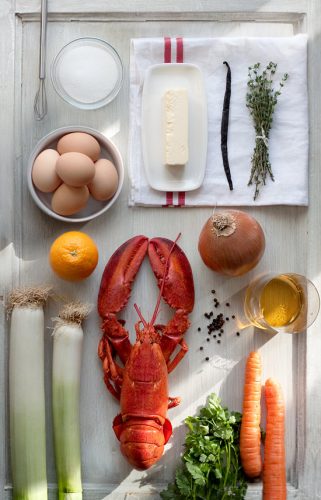
We have more or less refused to come back from our vacation in Mexico, and are obsessed with recreating the flavours we discovered there. This lobster double feature is something that appealed to us for many reasons: the cold/hot thing, the sweet/savoury thing, and naturally the whole weird idea of lobster ice cream. (See our bourbon and cigar ice cream, inspired by last year’s escape to Cuba.)We’ve never done a bisque before, and were interested to discover how the technique makes use of the whole beast, antenna-to-tail. Nothing is wasted. The lobster’s very essence is extracted. Luxuriance and simplicity. Two of our favourite things.
The setting of course played a factor in creating this indelible taste memory. We chose La Palapa for our last meal in Puerto Vallarta because it had tables for two on the beach, lit by candles and tiki-torches, a stone’s throw from the water.
lobster bisque with lobster ice cream
We have more or less refused to come back from our vacation in Mexico, and are obsessed with recreating the flavours we discovered there. This lobster double feature is something that appealed to us for many reasons: the cold/hot thing, the sweet/savoury thing, and naturally the whole weird idea of lobster ice cream. (See our bourbon and cigar ice cream, inspired by last year’s escape to Cuba.)
Most of the ingredients for the bisque and the ice cream are pictured here.We’ve never done a bisque before, and were interested to discover how the technique makes use of the whole beast, antenna-to-tail. Nothing is wasted. The lobster’s very essence is extracted. Luxuriance and simplicity. Two of our favourite things.
Discard the lobster legs after infusing the cream with them.
The setting of course played a factor in creating this indelible taste memory. We chose La Palapa for our last meal in Puerto Vallarta because it had tables for two on the beach, lit by candles and tiki-torches, a stone’s throw from the water.
We had no idea the food would be so spectacular, or that the place was the first beach-front restaurant in the city. That Liz Taylor and Richard Burton probably met here for sunset cocktails after an arduous day of shooting The Night of the Iguana. Glamour isn’t an ingredient in this bisque, but somehow you can taste it.
NOTES: We saved the lobster meat for another dish, but you can slice it into the bisque for an even more intense lobster experience. The sweetness of the ice cream will exaggerate the savoriness of the bisque, so under-salt it slightly.
For the ice cream
2 C heavy cream, divided
1 C whole milk
1/2 C sugar
a pinch of fine sea salt
¼ tsp. ground white pepper
5 egg yolks
1 vanilla bean
the legs of two cooked lobsters, cracked with a mallet
¼ tsp. sweet paprika
In a medium saucepan, combine 1 C of the cream with the milk, sugar and a good pinch of salt. Warm over medium heat, stirring occasionally, until frothy bubbles start to form around the edge of the pan. Turn off the heat and add the vanilla bean and lobster legs. Cover and infuse for an hour.
Meanwhile, lightly beat the egg yolks in a medium bowl. Nearly fill a large bowl with ice and water. Rest a smaller bowl in this ice bath. (The smaller bowl should be big enough to hold all of the ingredients comfortably.) Pour the remaining 1 C cream into the smaller bowl, to chill it. Set a fine-meshed sieve over the cream.After an hour’s infusion, remove the vanilla bean, stir in the paprika, and re-warm the cream mixture until frothy bubbles again appear around the edge. Dribble about half of the hot cream mixture into the egg yolks, whisking constantly. Then pour this yolk-cream mixture back into the saucepan and stir to combine. Cook over low heat until the custard coats the back of a spoon (175-180º F). Stir constantly and do not overcook, or the custard will curdle.
Strain the hot custard into the cold cream. Push firmly on the lobster to extract any juices. Cool the custard to below 70º F by stirring it slowly over the ice bath. Refrigerate the custard in a sealed container for 4 hours. If you have an ice cream maker, freeze the custard in it.If you don’t have an ice cream maker, freeze the custard for an hour, then mix it with a stick blender. Return to the freezer for an hour, then mix again. After a third hour, mix a final time, and freeze for at least another hour before serving.
For the bisque
Two cooked female lobsters
9 tbsp. butter, divided
2 carrots, finely diced
2 leeks, chopped
2 shallots, chopped
2 cloves of garlic, chopped
4 strips of orange zest
2 tsp. black peppercorns
2 tbsp. tomato paste
8 thyme sprigs
3 tarragon sprigs
¼ C cognac
5 tbsp. flour, divided
8 C hot fish stock
½ C vermouth (or white wine)
2/3 C heavy cream
salt and pepper to taste
Pull the legs off the lobsters. Using a cleaver, chop the lobsters in half lengthwise. Separate the claws and tails from the bodies. Remove the tomalley and roe from the bodies and reserve. Remove the meat from the claws and tails. Reserve any juices from the lobster. Reserve the meat for another purpose and the legs for the ice cream.In a Dutch oven, melt 6 tbsp. of the butter over medium-high heat. When the foam subsides, add the empty shells of the lobster (claws, tails, and bodies), the carrots, leeks, shallots, garlic, orange zest, peppercorns, tomato paste, thyme, tarragon, and a light sprinkling of salt. Sauté, stirring frequently, for 12-15 minutes, or until the vegetables are completely soft.
Make a well in the centre of the pot, and pour in the cognac. When it is warm, set it alight with a match. Let it burn for about 30 seconds, allowing it to scorch the shells slightly, then extinguish with a lid. Into the hot well of cognac, sprinkle 2 tbsp. of flour. Stir the flour in the cognac for a minute, cooking it slightly. Then stir to blend all the ingredients in the pot and continue to sauté a 3 final minutes.Add the hot fish stock, vermouth, reserved tomalley and roe, any reserved juices, reduce the heat to medium-low and bring to a simmer. Reduce the heat to low and simmer for 40 minutes, stirring occasionally. Strain everything through a fine sieve or a colander lined with cheesecloth, into another large pot. Return the strained soup to minimum heat, add the heavy cream, and stir to combine.
Make a paste (a beurre manié) from the remaining 3 tbsp. of butter and 3 tbsp. flour. Whisk this, a teaspoon at a time, into the hot soup, incorporating each teaspoon completely before adding another. You may not need to use all of the beurre manié. Stop when the texture has homogenized, and thickened to a soft velvet. Make sure you cook the soup for at least another 2 minutes, so the flour does not taste raw. Season judiciously with salt and pepper, and serve.



